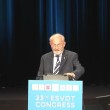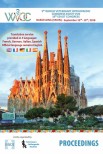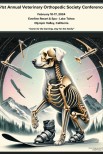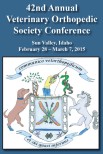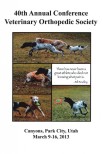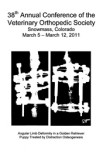 William R. Redding, DVM, MS, DACVS
William R. Redding, DVM, MS, DACVS
Associate Professor, Equine Surgery
North Carolina State University
Proximal Suspensory Desmitis (PSD)
RL: Hind limb proximal suspensory desmitis (PSD) has become a more frequently recognized condition. In your clinical setting what do you base your diagnosis on?
RR: We can’t rely too much on breed and discipline as an indicator of incidence in our practice. It seems to affect many disciplines. Regardless of incidence we rely on the use of diagnostic analgesia to define the proximal plantar region as the source of pain. We think it is important to eliminate the distal limb first by performing a low six point before performing the deep plantar nerve block. I like to block the tarsometatarsal joint and distal intertarsal joint before I perform the deep plantar nerve block. If there is only mild improvement to either of these joint blocks then the deep plantar nerve block is performed. At least a 70% improvement in the baseline lameness is expected if this region is the source of pain
RL: How reliable is the use of ultrasonography and where does MRI come into play with respect to making a diagnosis of PSD? Has nuclear scintigraphy (soft tissue phase imaging) been a rewarding imaging modality for you?
RR: We have been fortunate to have received funding from the Bernice Barbour Foundation to perform a study using MRI on horses with suspensory ligament injury. By far the most common injury has been proximal suspensory desmitis of the hind limb. We see quite a few PSD of the front limbs but they have historically done very well with conservative therapy so we have elected to not perform MRI examinations (due to the risk of anesthesia) unless there was some complicating factor (splint exostosis, normal findings on radiography, ultrasonography or nuclear scintigraphy). Because the hind limb PSD cases have a much more guarded prognosis we have elected to examine these as frequently as possible. To date there have been 25 horses with hind limb PSD included in this study. These horses have been blocked following the previously described technique. Of these 25 horses 17 horses suffered unilateral lameness (two had bilateral PSD seen on MRI) while 8 were bilaterally lame (2 horses had no significant findings on either suspensory while 2 horses had unilateral PSD). Six horses were diagnosed with primary PSD, 7 horses had a combination of primary PSD and osseous abnormalities, 8 horses with primary osseous abnormalities (without desmitis) and 4 horses with no obvious abnormalities
Twenty three horses had diagnostic ultrasound performed. Agreement between the appearance of the lesion on MRI and ultrasonography was generally poor. There were 9 ‘true positive’ ultrasonographic examinations, 12 ‘false positive’, 1 ‘false negative’ and 1 ‘true negative’ in 23 horses. The positive predictive value of an ultrasonographic abnormality in the proximal part of the suspensory ligament was found to be as low as 43%.
I used to believe that blocking before an ultrasonographic exam wouldn’t influence the diagnostic quality of the exam. However, recent experience performing ultrasonography of the proximal suspensory region of both front and hind limbs (following several different clinicians) has shown that the blocking technique can seriously compromise the diagnostic utility of ultrasonography. The amount of gas that is in the local anaesthetic solution after aspiration into the syringe and injection appears to affect sound transmission. We now ultrasound the proximal plantar metatarsal region before any local nerve block is performed if we suspect this area is clinically significant. If the horse has been blocked to this region prior to ultrasonography we recommend performing the examination on the following day.
At present, we try to perform our lameness examination and diagnostic analgesia (as described above) the same way in every case but obviously this is clinician dependant. We continue to perform radiography and ultrasonography to investigate the proximal plantar metatarsus but recognize that these imaging modalities are inaccurate. Nuclear scintigraphy has proven to be inaccurate in PSD as well. I don’t think that nuclear scintigraphy is very accurate for imaging soft tissue injuries in general but that is my opinion and not necessarily shared by all clinicians. In some of the horses that have had MR examination of the proximoplantar metatarsus nuclear scintigraphy did demonstrate a positive response in some cases. It may prove helpful in some of those osseous lesions not related to suspensory desmitis. In the study of MRI of PSD some of the primary osseous pathology that demonstrated positive nuc med studies included intertarsal ligament enthesiopathy and fractures of the plantar aspect of the 3rd & 4th tarsal bone.
Based on our experience with MRI and PSD we are very comfortable recommending this modality to get the most accurate assessment of what the horse’s clinical problem(s) are and to allow more accurately instituted treatments.
RL: Where are lesions of the proximal suspensory ligament commonly located?
RR: Most of the lesions of the suspensory ligament (SL) were generally identified as focal or generalized areas of signal hyperintensity in the proximal part of the SL. Most had significant enlargement of the cross sectional area (CSA) and, in some cases, an adhesion between the dorsal surface of the affected lobe of the SL and the plantar cortex of the metatarsus. Of the 13 horses with primary desmitis, 12 horses had focal to generalized hyperintense signal within the ‘core’ of the SL, clearly indicating the presence of architectural change in the ligament. Eight of these core lesions were localized more in the dorsocentral aspect of the SL, while 2 occurred in the plantarocentral area. Two horses had peripheral signal changes in the lateral aspect of the lateral lobe of the SL. One horse had overall enlargement without architectural change. In 9/12 horses with a ‘core’ lesion, the architectural change occurred in the collagenous part of the SL rather than the muscular part. In the majority of horses hyperintense signal extended between 6 and 11 cm distal to the level of the TMT joint.
RL: Have you seen lesions involving the tarsal extension of the ligament?
RR: The tarsal extension of the proximal suspensory is made up of the plantar-central aspect of the SL. There have been a few cases of injury in this location but I can’t remember the injury extending any further than the tarsometatarsal joint. Interestingly, one horse with this injury (plantar-central desmitis) also had a very remarkable bilateral signal increase in the proximal Mt4 and T4 even though the desmitis was unilateral. I’m afraid I can’t say which came first or if one is a predisposition to the other.
RL: Is there such a thing as a compartment syndrome leading to neural pain?
RR: I am not aware of any scientific proof that there is a compartment syndrome that occurs in this area. This theory however does make sense from a clinical standpoint. We have not been able to see consistent swelling (on MR examination) to the extent that it might compromise the nerve(s) in this area. There were a few severe SL injuries that could have easily compromised the nerve but most injuries did not present with enough swelling to be a concern. Dyson has reported histological evidence of neuritis in the deep branch of the lateral plantar nerve in clinically affected horses. Unpublished material from Schumacher also confirms neuritis in this nerve in horses that have had a neurectomy performed for treatment of PSD when the nerve was examined histologically. There have been 4 or 5 horses in which MRI was unable to demonstrate significant findings but that were effectively managed by local injection of corticosteroids and serapin. Whether this was addressing a neuritis or inflammation in another structure not apparent on MRI is unknown.
RL: Have you found bilateral lesions on MRI when lameness is unilateral?
RR: I would have to say that we have not found lesions of the PSD that didn’t block appropriately. In other words, the horses that had bilateral PSD tended to switch to the opposite limb after the most severe lameness (associated with the proximal plantar region) was blocked and it required a deep plantar nerve block to eliminate the opposite limb lameness. However, horses with bilateral lameness did not always have bilateral PSD. The opposite limb lameness didn’t necessarily block to the proximal plantar region in all these horses. When we began using MRI to examine this area the most surprising finding was that approximately a third of the horses had osseous lesions without any evidence of desmitis of the SL. It may very well be that those numbers will change as we get more horses into the magnet and the study population becomes more diverse. The first group of horses we examined tended to show more chronic lameness that consistently blocked to this area but had not responded to conservative treatment. There has also been a small group of horses we classified as showing a normal MRI scan because they had no architectural change in the SL. However these horses’ SL was misshapen and had adhesions to the plantar cortex or lateral splint bone.
RL: In horses with PSD do you commonly see composite lameness (ie: other sources of lameness contributing to the clinical picture?)
RR: In horses with PSD of the hind limb it would be difficult to determine if lameness originated from somewhere else on the same limb. Much like the front limb, you methodically block the lower limb out before blocking the most intense source of pain in the origin of the suspensory ligament. My experience with PSD of the front limb suggests that there are probably other areas of the limb that may be contributing to the lameness. This becomes most apparent when the horse is being rehabilitated. In some horses that continue to manifest lameness for 2-3 months we have repeated our blocks and found that the lameness is now associated with the foot.
In the PSD of the hind limb of horses that were bilaterally lame we did see a variety of causes of lameness in the opposite limb that we felt were compensatory in nature. There were a few horses that had an unusual pattern of signal change in the medullary cavity of proximal Mt4 and T4 in conjunction with the PS desmitis although not all these horses were manifesting lameness in both limbs. These horses tended to have a primary lesion in the plantar aspect of the suspensory ligament.
RL: Where you fortunate enough to follow-up horses performing repeat MRI examinations? Does abnormal MRI signal change?
RR: No we have not had the opportunity to rescan any of these horses. That is really where we wanted the next part of our study to take us. We wanted to further evaluate some of these MR confirmed PSD with repeat scans. We also wanted to evaluate the effects of some of these different procedures that are performed for injuries to this area utilizing MR. I think we need to carefully evaluate tendon and ligament repair using MR as well as how repair is influenced by the utilization of stem cells.
RL: What are your treatment recommendations?
RR: Treatment is determined by the specific structure and location of injury as well as the duration of injury. If there is a discrete lesion of at least 15-20 percent of the cross sectional area of the suspensory ligament then we discuss with the owner the potential for intra-lesional treatments such as stem cells. If this is an option then we harvest mesenchymal stem cells from a bone marrow aspirate of the sternum which is then further processed and augmented by Vet Cell. We have used fat derived stem cells (Vet Stem) but have been concerned that there is a much lower number of stem cells in this sample that with the Vet Cell technique. In acute injuries of the suspensory ligament at the origin our treatment recommendations are to minimize the swelling in this area by a local injection of corticosteroids and Adequan. The goal of this treatment is to minimize the extent of the inflammatory response that exists in the paratenon and ligament in an attempt to prevent a compartmental syndrome which may occur due to swelling of the ligament under the tense retinacular band. In one week, this is followed by a course of focused shockwave. We like to perform three treatments each 2-3 weeks apart. At 8-10 weeks after instituting treatment the horse is re-evaluated. If the lameness is still present we recommend surgery to perform a retinacular release and neurectomy of the deep branch of the lateral plantar nerve. I initially resisted performing neurectomies because of the belief that an injured tendon/ligament would not heal appropriately if the sensation was removed and the horse was allowed to travel normally. Pain is a protective mechanism. However, the first several horses that had MR confirmed core lesions had stem cells harvested and injected at surgery. At surgery to inject these cells we only performed a retinacular release intentionally not performing a neurectomy. Unfortunately, all horses had to have a neurectomy performed 4-6 months later to become sound.
In terms of orthopaedic shoeing and remedial farriery very little work has looked at the effects of shoeing on the stress in the origin of the suspensory in the hind limb. We feel maintaining a straight toe/pastern axis with application of an egg-bar shoe should suffice.
RL: What is your take on PSD being caused by a systemic disease affecting the proteoglycan composition as recently suggested?
RR: We have become concerned about a systemic problem when there is bilateral, moderate to severe PSD or the existence of another front limb having a suspensory ligament injury. We have submitted biopsies of the nuchal ligament to the University of Georgia to determine if these horses have what they have reported to be a proteoglycan storage disease. This is an ill-defined condition that so many of us have previously called degenerative suspensory ligament disease. Unfortunately, there is still little about this condition that we do know. All of the horses that we were concerned about have had positive biopsies for the disease but I am not quite sure that I know what this means. We need to submit samples from a large number of unaffected horses to determine how many normal horses are positive using this biopsy technique. Then questions arise as to what is the long term prognosis for these horses? Are there any nutritional or management techniques that will allow further athletic use of these horses? Is this a hereditary condition? Answers to all of these questions remain unknown at this point.
RL: Thank you for your time!


